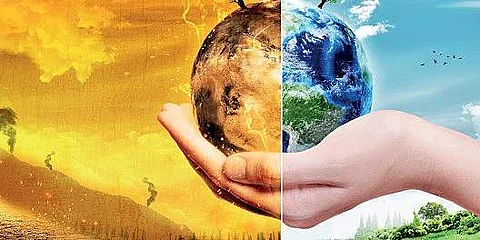

In recent years, a considerable number of changes have been noticed in the weather pattern all over the world. Extreme events like cyclones, heavy rainfall, extreme drought and wildfires have gone up considerably. All these are indicative of climate change that was predicted decades back. Many people were sceptical, but the recent events confirm that it is real and, if unchecked, can have devastating impacts. In India, we have seen a shift in the monsoon pattern and the frequency of cyclones has nearly doubled annually. The frequent landslides in Uttarakhand, severe floods in Odisha and Assam, heavy rainfall and droughts in Maharashtra are cases in point.
The sun is the major source of energy for the earth. Radiation gets coupled with the earth’s atmosphere, land and ocean. This decides our weather and climate. Energy output from the Sun has changed over time. In the formative years—4.5 billion years ago—the intensity of solar radiation was only 70% of what it is today. Though the sun’s radiation was increasing, there were periods of cooling and warming that are attributed to a possible shift in the earth’s axis of rotation. This means that climate has undergone changes even before human existed. The present climatic conditions set in after the polar glacier melted nearly 10,000 years ago. During this period, the sun was warming continuously that led to melting of ice and caused an increase in ocean temperature. Later, the enhanced CO2 emissions accelerated the warming.
The average temperature is the result of a fine balance between the energy absorbed by the earth from the sun and the amount radiated back into space. There are a number of factors which dictates this balance. One such element is the concentration of greenhouse gases such as CO2 and methane. In addition, water vapour, aerosols, ozone, etc., play a significant role. Many of these constituents cannot be controlled. What can be done is to reduce greenhouse gas emissions, preserve natural forests and water bodies and plan our land use.
Studies by the Intergovernmental Panel on Climate Change (IPCC) concluded that the change in average temperature and CO2 are correlated. Whenever there is an increase in CO2, the average temperature goes up. Today, it stands at 1.1 degrees over the pre-industrialisation levels. The concentration of CO2 increased from about 289 ppm before the Industrial Revolution to over 412 ppm. It is still increasing. It is predicted that by the end of this century, the CO2 concentration will reach twice what it was before the Industrial Revolution. The increase in CO2 emissions was exponential after 1950 and a corresponding rise in temperature was also noted. If this trend continues, the temperature rise may touch even 4.5 degree Celsius by the end of the 21st century.
In 1950, the emissions of the US and developed European countries were more than 85% of the total output. But as development in Asia, Africa and South America picked up speed, their emissions went up to about 53%. Today, China is the largest contributor to CO2 emissions with 9.8 billion tonnes annually followed by the US at 4.8 billion tonnes and India at 2.8 billion tonnes. Developing countries feel the developed world should bear the cost of mitigation as well as help with technology and resources to achieve carbon neutrality. One of the major issues before the UN is the resolution of this problem.
Meanwhile, mechanisms such as the UNFCCC and conferences such as the Earth Summit took shape. Later, the Kyoto Protocol acknowledged that developed countries are historically responsible for the current levels of greenhouse gases and, hence, have a larger obligation. The Paris Summit aimed at limiting global warming to well below 2, preferably to 1.5 degrees Celsius, compared to pre-industrial levels. Blindly going for carbon reduction and forgetting the basic needs of humans is fashion today. Instead, a well-balanced sustainable development programme is needed.
At the Kyoto Protocol, emissions reduction targets for developed nations were agreed and it was revised during the Paris Conference and reiterated in Glasgow. Most of the countries have come to an agreement that before 2030, carbon peaking will take place and that they will work towards achieving net zero emissions. The Glasgow Summit has left several issues unresolved with funding being a major one. Though most of the developed countries agreed to raise $100 billion, it remains a dream. It is their moral responsibility to help the developing world not only with money but also with technology.
At Glasgow, PM Modi declared that India will achieve carbon neutrality by 2070. This target is to be achieved through reduction in fossil fuel usage, increasing the share of renewables, improving the automobile emission standards and reducing power consumption in the manufacturing sector. The PM has taken the initiative to form a global cooperative network for solar power. The target of achieving 500 gigawatt of electricity through renewable energy sources meeting 50% of India’s power needs by 2030 is an ambitious goal. Use of fossil fuel in the transport sector is being reduced by the use of electric traction, use of hydrogen as fuel and encouraging mass transportation systems. Legal framework is being instituted to reduce power consumption in manufacturing. Efforts to restore and rejuvenate forests are also being undertaken. Through these positive actions, India is committed to the global cause of reducing emission of greenhouse gases.
G Madhavan Nair
Former chairman, Indian Space Research Organisation